Hurricane Lee reminds NC’s Outer Banks of the risk posed by these Rodanthe homes
The surf ran up the beach, eager to greet the front steps of a pair of homes in Rodanthe on Friday.
These homes, sitting on the open beach just past the end of East Point Drive, weren’t alone in the surf. Up and down the beach, waves churned around the pilings of several other houses.
Hundreds of miles away, in the Atlantic, Hurricane Lee continued to make its way north, now a Category 1 hurricane with 80-mile-per-hour winds stretching 70 miles from its center. Its winds would start to reach Canada on Saturday, sparing North Carolina and the Outer Banks from the worst impacts.
N.C. Department of Transportation crews monitored N.C. Highway 12 throughout the day, building up dunes as drivers steered through overwash. Highway signs warned everyone to stay out of the ocean because of the increased risk of rip currents, warnings that were largely heeded. At Oregon Inlet, a fleet of charter fishing boats sat at their docks, bobbing in water but not daring to test seas with waves of nine to 12 feet off of the Outer Banks.
But in Rodanthe, where about a dozen homes sit eastward of any dune line, the homes had no choice but to end up in the surf. In recent years, five oceanfront homes have fallen, sending lumber and nails and insulation up and down the coastline, and leaving behind abandoned septic tanks that can burst open.

When they were built, the homes weren’t on Park Service land, but rapid erosion means they’re now located on a beach that belongs to the Cape Hatteras National Seashore. Government agencies from the National Park Service to the N.C. Division of Coastal Management to Dare County are worried about the homes and their potential impacts.
“They all have different degrees of vulnerability based on their exposure to the ocean, meaning how close they are, and then how sensitive the structure is based on its construction,” David Hallac, the superintendent of the Park Service’s Cape Hatteras National Seashore, told The News & Observer.
The beach around Rodanthe is eroding more than 10 feet per year, according to a May study prepared for Dare County. That study also found the dune line in the area offers “little to no storm protection.”
Alyson Flynn, a coastal advocate and environmental economist for the N.C. Coastal Federation, moved to the Outer Banks in 2017. Even then, she said, the northern Rodanthe homes seemed to be situated much more safely than they are now.
“There was a whole other street in front of some of those homes that you could actually drive out on,” Flynn told The N&O. “I’ve slowly seen that kind of wash away.”
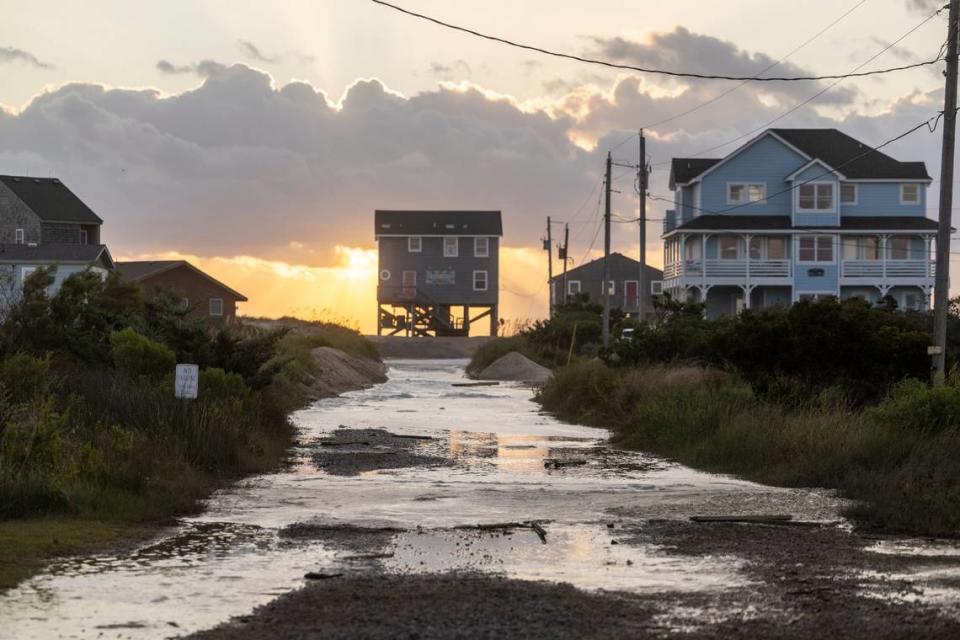
The N.C. Division of Coastal Management and Park Service have established a working group to discuss the options for threatened oceanfront homes and other structures.
That group has held two meetings, with a third scheduled for Oct. 11. Originally scheduled for Aug. 30, the third meeting was rescheduled due to potential impacts from Hurricane Idalia moving past the Outer Banks.
“We know the situation is only going to get worse. These are barrier islands, they are dynamic environments that are intended to move, and especially in an age of sea-level rise this problem is only going to get worse. The need to get ahead of it is paramount,” Sierra Weaver, a Southern Environmental Law Center senior attorney, told The N&O.
Cleaning up home collapses
This May, a one-story home that had been located on East Point Drive fell into the ocean while a surf advisory warned of eight- to 12-foot waves. Debris from the home was strewn across at least a half-mile of the beach, McClatchy reported at the time.
A trio of homes on Rodanthe’s Ocean Drive collapsed in 2022, including one in February that was broken apart in the surf and left debris spread across the beach for miles.
Hallac warned that a collapsed home’s impact on nearby beaches can grow dramatically if it is left in the ocean. During some of the recent collapses, debris has been found about a dozen miles away from where the home fell.
“The debris is bobbing around right in the surf zone. It can go from 10,000 pieces to 100,000 pieces as the waves break it up. Then debris can spread long distances along seashore beaches,” Hallac said.
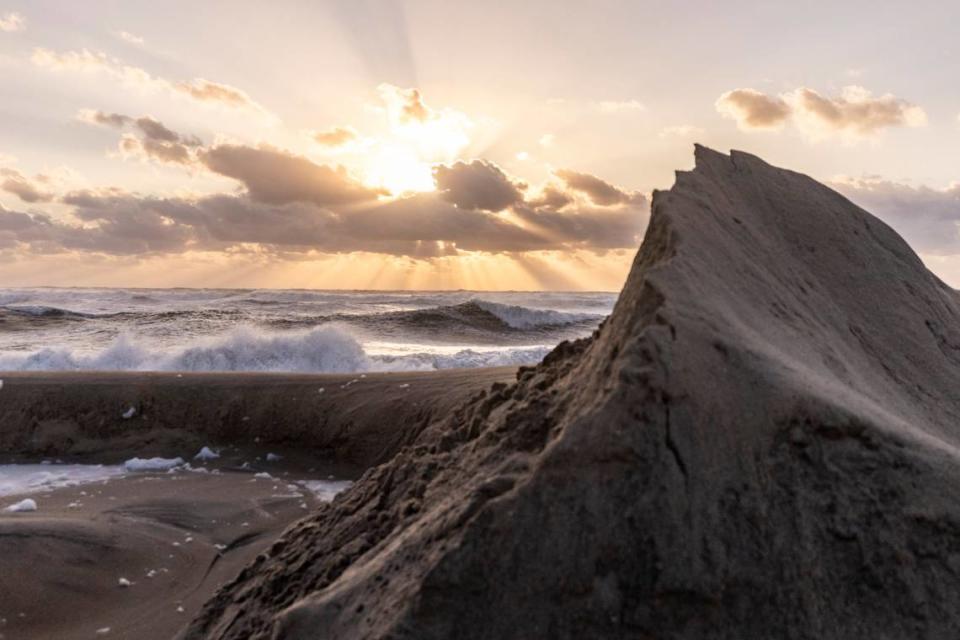
The Park Service urges homeowners to have contractors and other resources ready to go to remove the debris from a fallen home or clean up a septic tank that’s been cracked open by waves.
But, Hallac said, “Thus far, I don’t think we’ve had an owner that was prepared to really clean up promptly. But to be fair, I’m not sure that anybody knew what it took to do a complete, quick cleanup.”
When a home falls, Weaver stressed, it doesn’t just impact the owner who needs to pay to clean it up or decide what to do with their homes.
“It’s not just about the houses and where they’re going,” Weaver said, “but what are we talking about in terms of the American public and their ability to use this national resource, this national treasure out there on the Outer Banks.”
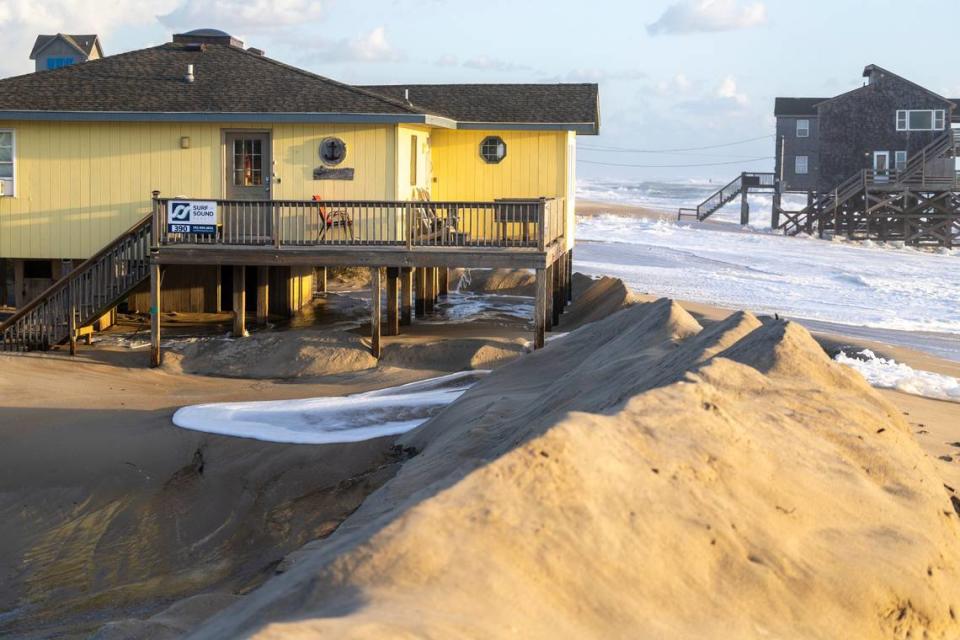
After the March collapse, Hallac decided to deploy Park Service staff to clean up the debris. Using about 40 staff members, most of the larger debris was cleaned up within days and the rest within a week. Other cleanups around Rodanthe have taken more than a month because the debris spread so quickly.
Several homes in Rodanthe have yellow tags on them, indicating that they’re uninhabitable, Bobby Outten, the Dare County manager, told The N&O. The county’s building inspectors make that determination for a number of reasons, ranging from the destruction of stairs making the house inaccessible to the destruction of a drain line running to the home’s septic tank or the bending of one of the pilings holding the structure up.
“We can shut them down, we can make them uninhabitable where they don’t create income and all that, but beyond that we don’t have any tools,” Outten said.
The septic systems pose a particular problem in an oceanfront environment. Sometimes, the moving sand uncovers the tanks, leaving them vulnerable to powerful waves that can crack them open and spill their contents across the beach.
Often, those septic tanks aren’t hooked up to a home anymore and it will be unclear who is responsible for it.
“We hope that the owner is going to pump the tank out and remove it, but I can tell you that’s not always happened,” Hallac said.
The Coastal Federation and Southern Environmental Law Center have urged local and state officials to establish new rules around septic tanks to limit their impacts in vulnerable coastal environments like Rodanthe.
The N.C. Coastal Resources Commission is considering one potential change, updating septic-tank rules to require any relocated septic tank that is on the ocean-facing side of the vegetation line to receive a state permit. It would also require owners to remove the existing septic tank and its components as part of placing a new one, preventing the addition of more unaccounted-for tanks.
“These rules are trying to make it so that these tanks aren’t on a public beach anymore and try to stop this situation of being able to continually replace your septic tank,” Flynn said.
Nourishment, buyouts and other options
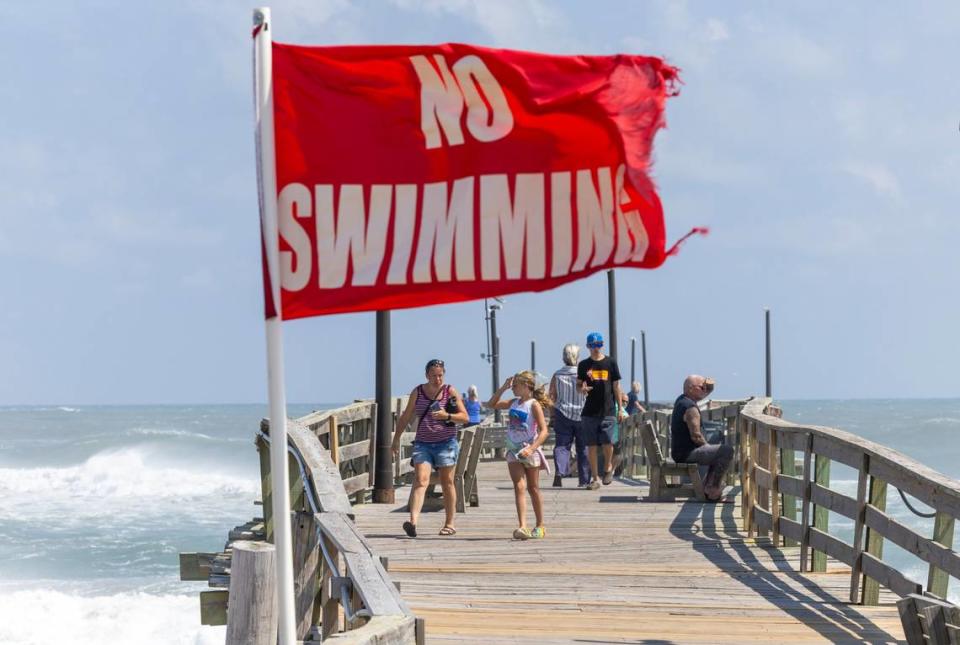
Many homeowners in Rodanthe have advocated for a beach nourishment project, arguing the best way to protect their homes is by putting more sand in front of them. But the project could come with a price tag of as much as $40 million, and Dare County doesn’t have the money to pay for it.
Outten estimated that Dare County has $8 to $10 million in its beach nourishment fund, which the county uses to pay for projects up and down the Outer Banks.
County leaders want the U.S. Army Corps of Engineers to study funding nourishment in Rodanthe using federal money. But studying the possibility would take as much as three years, and then the project would need to be funded.
“The problems that we have will persist until we figure out a funding source to make it work there,” Outten said.
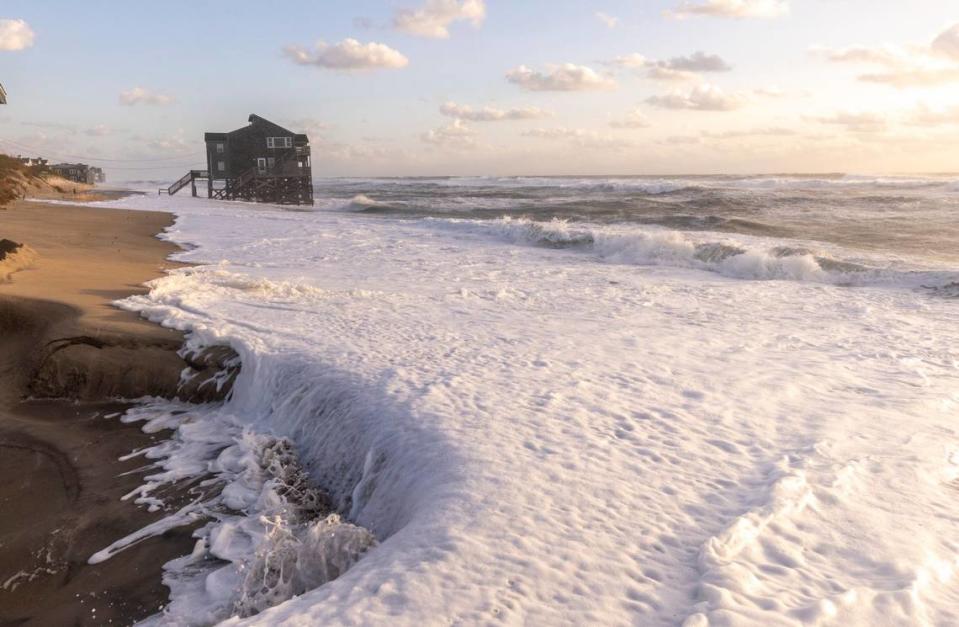
Not everyone is in favor of nourishing the beach around Rodanthe.
A previous nourishment project in the area was conducted to protect a then-vulnerable portion of Highway 12, the road that serves as a vital lifeline to Rodanthe, Avon and Hatteras. But that portion of road, once known as the S curves because of its windiness, no longer exists. It’s been replaced by the new Jug Handle Bridge, which swings out into the Pamlico Sound and bypasses the flood-prone areas entirely.
Without the road, Flynn said, a nourishment project would be conducted solely to protect private homes. That’s different than every other nourishment project on the Outer Banks, which also protect the road and other infrastructure.
“It would be difficult to see the benefit other than the protection of private property. So that’s certainly not ideal in our minds,” Flynn said.
Some owners have already started paying to move their homes back from the ocean, buying time and hoping for a solution.
Another option would be for Dare County to condemn the ocean-threatened houses, buy them and tear them down to prevent debris from scattering across the shore. But Outten quickly discounted that, saying it would displace money that could be used for a beach nourishment project.
“If we bought 10 houses, next year there’s going to be 10 more,” Outten said. “So what did we accomplish? Because the erosion’s still occurring.”
Dare County did explore the possibility of using funds from the N.C. Office of Recovery and Resiliency to buy and destroy homes in the area.
But it quickly became clear that establishing a so-called “strategic buyout zone” for what are almost entirely second homes in Rodanthe wouldn’t be high on the state’s list of priorities for disaster-relief funds, Outten said.
“If you take care of all the underserved communities and then you take care of all the primary residences, there’s really not a lot of money left,” Outten said.
North Carolina isn’t the only place with valuable property next to an eroding shoreline, Outten said. He points to the Great Lakes and Nantucket as places that are facing similar issues. But, like everyone sorting through the different levels of bureaucracy and responsibility right now, Outten isn’t sure where a solution will come from.
Flynn, the Coastal Federation advocate, is optimistic the inter-agency working group will point officials toward solutions.
“It’s a difficult situation, but we’re able to be role models and basically set precedent for when other states and areas have this problem,” Flynn said. “There’s really no clear model right now from any other state on how to best address this. I think many eyes are going to be on North Carolina.”
Photos: Hurricane Lee’s impact felt along NC coast
This story was produced with financial support from the Hartfield Foundation and the 1Earth Fund, in partnership with Journalism Funding Partners, as part of an independent journalism fellowship program. The N&O maintains full editorial control of the work.


